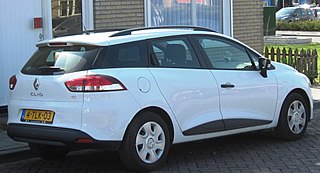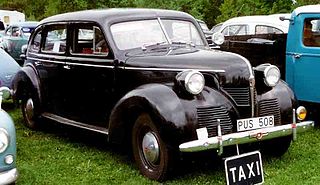
A station wagon, also called an estate car or wagon, is a car body style which has a two-box design, a large cargo area and a rear tailgate that is hinged to open for access to the cargo area. The body style is similar to a hatchback car, but station wagons are longer and are more likely to have the roof-line extended to the rear of the car to increase the available cargo space.

The Volvo Amazon was a mid-sized car manufactured and marketed by Volvo Cars from 1956 to 1970 and introduced in the United States as the 122S at the 1959 New York International Auto Show.

The Duett is an automobile from Volvo that was in production from 1953 to 1969.
The Volvo PV is a series of two-door, four-passenger car models — the PV444 and the PV544 — made by Volvo from 1947 to 1966. During World War II's early stages, Volvo decided that a new, smaller car that could deliver good fuel economy would assure the company's future. A raw materials shortage during the war drove home the point that an automobile should be smaller, and also complicated Volvo's ability to mass-produce the product. In 1944, when the car was finally introduced to a car-hungry public, response was very positive and orders poured in from the Swedish population. It was another three years though, until 1947, before series production began.

Volvo's first overhead valve passenger car engine was the inline-four B4B of 1944 and its descendants, the B14A and B16. These were cast iron engines, and used just three main bearings.

The Volvo Sport is a Swedish fiberglass-bodied roadster of which sixty-eight units were built between 1956 and 1957 by Volvo Cars.

Volvo Cars, stylized as VOLVO, is a Swedish luxury automobile marque. It is headquartered in Torslanda in Gothenburg, Sweden.

The Volvo 164 is a 4-door, 6-cylinder luxury sedan unveiled by Volvo at the Paris Motor Show early in October 1968 and first sold as a 1969 model. 46,008 164s were built before the car was succeeded by the 264 in 1975. The 164 was Volvo's first venture into the luxury segment since the end of PV 60 production in 1950, and was the first six-cylinder Volvo since the PV800 last produced in 1958.

The Volvo PV800 Series was a taxicab manufactured by Volvo between 1938 and 1958. The Sow series dominated the Swedish taxicab market during the 1940s and 1950s.

The Volvo ÖV 4 was the first car built by Volvo. The designation ÖV 4 stands for "Öppen Vagn 4 cylindrar" in Swedish, which means Open Carriage, 4 cylinders. The model ÖV 4 was often referred to as "Jakob" but that was just a name for one of the 10 pre-series ÖV 4 that was ready on 25 July, Jakob's name day. All 10 prototypes were assembled in Stockholm at the company AB Galco, Hälsingegatan 41 where Gustav Larson worked at that time. Only one of the 10 pre-series cars manufactured during 1926 was saved for posterity and is housed at the Volvo Museum in Gothenburg, Sweden.

The Volvo PV 36 Carioca is a luxury car manufactured by Volvo Cars between 1935 and 1938. The word Carioca describes someone from Rio de Janeiro, Brazil, and was also the name of a dance that was fashionable in Sweden at the time when the car was introduced.

The Volvo PV51 is a car introduced by Volvo in December 1936. It was replaced by the mildly restyled PV53 in 1938. This car remained in production until the end of the Second World War.

The Toyota Automobile Museum is a large museum showcasing Toyota's storied past. It is a large complex located in Nagakute city, a city close to Nagoya, Japan.

Jan Wilsgaard was the Chief Designer at Volvo Cars from 1950–1990, having studied at the Gothenburg School of Applied Arts before joining Volvo when co-founder Assar Gabrielsson still headed the company.

Kungliga tennishallen is a tennis venue at Lidingövägen 75 in Stockholm, Sweden. The stadium was built in October 1943 and has a capacity of 5,000. Kungliga tennishallen, now a hard-court surface, remains the venue for the men's Stockholm Open tournament which was first held in 1969. In 1975 the venue was the host of the year-end Masters tennis tournament as well as the Davis Cup final between Sweden and Czechoslovakia.

The Volvo PV60 is an automobile manufactured by Volvo between 1946 and 1950. It was the first car produced by the Swedish company after the end of the Second World War.

The Volvo PV650 Series is an automobile manufactured by Volvo between 1929 and 1937. The model name stand for PersonVagn, 6 cylinders, 5 seats; the third digit indicates the version.

The Volvo TR670 Series was a taxicab manufactured by Volvo between 1930 and 1937. The model name stands for TRafikvagn ("taxicab"), 6 cylinders, 7 seats; the third digit indicates the version.
Bill Rutan was a racing driver and hillclimb racer. Rutan was the winner of the Climb to the Clouds hillclimb in 1961. Rutan also won the SCCA National Championship Runoffs twice in the Formula C class.
This page is based on this
Wikipedia article Text is available under the
CC BY-SA 4.0 license; additional terms may apply.
Images, videos and audio are available under their respective licenses.























